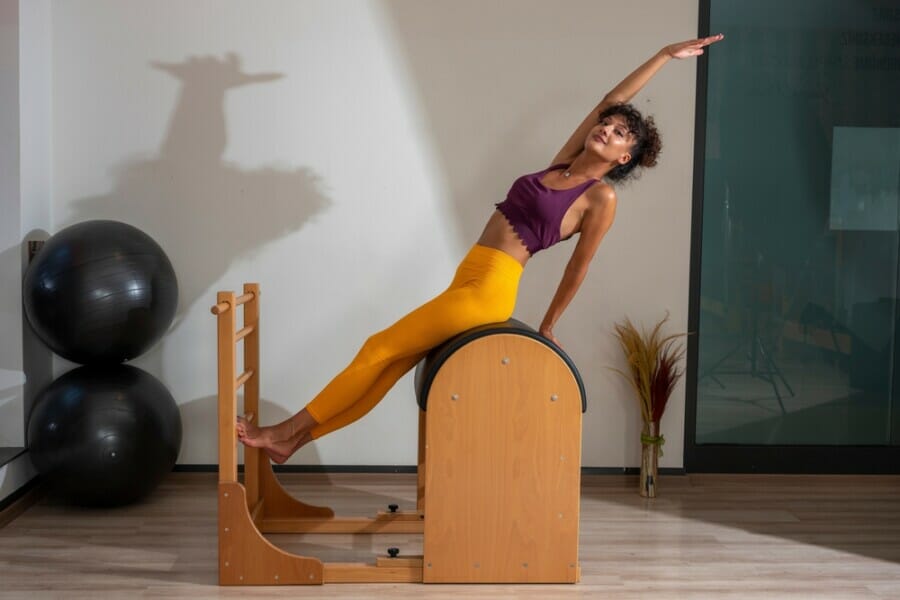Simple Tips To Enhance Your Pilates Routine
Pilates aficionados are well aware that this method of exercise, which emphasizes precision, breathing, and fluid movement, can offer a rigorous workout for both the body and mind.
Though the exercises may seem simple due to their diminutive nature, appearances can be deceiving; a single round of the famed Pilates hundred can make that abundantly clear.
Conceived by its namesake, Joseph Pilates, as a comprehensive exercise regimen focusing on postural alignment, balance, and strength, Pilates also aims to fortify your mental and emotional resilience.
For those eager to enhance the inherent benefits of Pilates and add some variety to their workouts, incorporating lightweight dumbbells into the routine is a brilliant choice. Generally, traditional Pilates movement doesn’t involve weights beyond 3 pounds, making it accessible for people across a wide spectrum of age groups and physical fitness levels.
Don’t be misled into thinking that adding weights makes for an easier Pilates practice. On the contrary, it poses its own set of challenges, similar to those experienced in a heavy weightlifting session.
Catherine Fair, a Stott Pilates-certified instructor at Life Time Westchester in New York, stresses the increased difficulty that even a 1-pound weight can introduce to the rigorous Pilates form.
Integrating weights into your Pilates program counteracts muscle and bone deterioration due to aging, enhances your mood, and prevents the sluggishness of workout plateaus. Continue reading to discover the myriad benefits that weighted Pilates exercises offer, along with tips to incorporate them safely into your routine.
Advantages of Integrating Weights into Pilates Practice
1. Strengthen Your Bones and Muscles
While weight training is commonly associated with muscle building, Erin Etienne, a certified Pilate instructor and master trainer at Club Pilates in Maryland, notes that many clients seek to employ weighted Pilates moves primarily to enhance bone density.
Indeed, resistance training has been recognized as a powerful tool to thwart the natural decline of bone density, potentially leading to conditions such as osteopenia and osteoporosis, and can even contribute to the formation of new bone tissue, as supported by Harvard Health findings.
Etienne explains that executing Pilates movements with weights can optimize circulation, which in turn safeguards joints by supplying vital nutrients and promoting healthy cellular turnover, thus bolstering bone strength.
Apart from the well-known muscle benefits attained through weight resistance training, which the Mayo Clinic affirms fosters muscle strength and lean muscle development, adding weights to Pilates moves transcends aesthetic gains.
Healthy muscles ensure efficient nerve function, heightened balance, and quicker reflexes—key elements in preserving functional mobility as we age, asserts Etienne.
Once you’re well-versed in the primary concepts of Pilates, incorporating weights can strengthen your mind-body synergy—one of the core pillars of the Pilates philosophy—according to Fair. She argues that weights not only amplify muscular development and allow for a more profound sensory experience during exercises but also help pinpoint the activation of smaller, more refined muscles.
2. Elevate Your Confidence
Confronting the realities of aging can invariably erode self-confidence, especially when it undermines our physical capabilities. Yet, working out with weights as part of a Pilates regimen can significantly bolster one’s self-assurance, Fair contends, even among experienced practitioners.
Bettering your form and deepening your understanding of each Pilates posture through added resistance can bring about a sense of achievement and intensify the sensation of a productive workout.
Adding weights can equally assist in setting and pursuing both short-term and ambitious lifelong objectives, such as preparing for a major race or enhancing daily pain-free movement, Etienne shares.
“Incorporating weights into your Pilates routine can empower individuals as they work towards their aspirations,” she states. “Hoisting even minimal resistance initiates the release of those feel-good endorphins, providing immense psychological relief for people coping with trauma or stress.”
“Pilates form is demanding even without additional resistance. Implementing a single pound can introduce a whole new dynamic.” —Catherine Fair, certified Stott Pilates instructor
3. Prevent Workout Monotony
Utilizing weights within Pilates sessions can inject much-needed novelty, warding off tedium and the dreaded training plateaus, Etienne elucidates.
“Blending in the right measure of weight that challenges your stamina, while allowing your nervous system to adapt and stabilize the load, is a brilliant strategy to maintain engaging, productive movements,” she suggests.
4. Identify and Address Muscle Imbalances
Conversely, using weights can expose underlying asymmetries within your body, as Etienne clarifies.
Often, clients are astonished to discover significant disparities in strength, coordination, and control when comparing different sides of their bodies. Etienne remarks that one of the goals of Pilates is to harmonize the body and facilitate fluid movement. “We achieve a smoother flow in our movements when we’re well-balanced.”
Awareness of these imbalances is crucial since they can lead to unhealthy movement patterns, particularly if compensating for injuries or pain, she adds.
Recognizing these personal limitations not only informs your practice and helps refocus your exercise goals; it also makes the sessions more immersive and engaging, Etienne concludes.
Considerations for Incorporating Weights into Your Pilates Exercise Plan
The philosophy of Pilates upholds that nothing should be done hastily, and this concept extends to the incorporation of weights into your regimen. Before employing any weights, it is imperative to have impeccable form, Fair cautions.
“Pilates is rooted in the mind-body connection, with control being one of its cornerstone principles,” Fair states. “Learning the precision required for each movement and prioritizing the core as the initiating point for action is paramount. Once you’ve grasped and refined the essential Pilates concepts, you can begin introducing weights to escalate the challenge, remembering that maintaining proper form is key.”
Fair suggests ensuring mastery over several fundamental Pilates precepts, such as:
- Harmonizing breath with movement
- Engaging your core muscles prior to secondary muscles
- Commencing movements in proximity to your trunk before extending them further outward
If you’re poised to begin a weighted Pilates exercise regime, bear in mind that the focus isn’t on lifting heavy. Fair explains that typical Pilates weights range from 1 to 3 pounds. Some popular choices include light hand weights suitable for a variety of exercises, as well as weighted ankle straps, which are optimal for targeting the muscles of the glutes and hips in lower-body routines.
Toning balls – soft, pliable orbs filled with weighted material – are another effective tool for enhancing strength and coordination within your Pilates practice, whether used for upper-body strengthening or stabilizing the core.
Toning balls, filled with sand, are some of Fair’s most favored tools, thanks to their versatile application. “These balls awaken the senses in your hands and feet and can be used to enhance arm exercises, engaging small muscles in your hands and wrists. Additionally, they strengthen the shoulder region and boost grip strength,” she indicates.
Adding a toning ball between your legs or knees while performing core exercises can increase their intensity, according to Fair. “I’m partial to using them for bridge poses to heighten foot sensitivity and to amplify the workout for the glutes, hamstrings, and calves,” she adds. “Whenever I bring out the toning balls, my students brace themselves for a serious workout!”
Fair also shares additional advice for incorporating weights into Pilates sessions:
- Be sure to master the exercise technique before introducing weights.
- The exercise should dictate the weight’s motion, not the other way around.
- Be in tune with your body and distinguish between discomfort and the exertion of effort.
- If an exercise causes pain, reduce the weight or discontinue its use.
“Even a minor amount of weight lifting can trigger those wonderful endorphins and make us feel uplifted, which is particularly beneficial for individuals recovering from trauma or dealing with stress.” —Erin Etienne, certified Pilates instructor
Guidelines for Safely Integrating Weights into Pilates
Although integrating weights into Pilates can enhance your workout, it’s not suitable for everyone. Etienne suggests avoiding weights if you suffer from injuries to your joints or muscles, balance disorders, restrictions in wrist and hand movement, neurological issues, a recent surgery, or if your doctor has recommended avoiding physical activity involving weights.
Consulting a doctor before starting Pililes is always recommended. Once you have approval, it’s crucial to begin your practice under the guidance of a certified Pilates instructor rather than trying to work through limitations by yourself. Etienne advises, for instance, that those with osteopenia or osteoporosis should steer clear of movements involving weight that flex the body, and individuals with shoulder conditions should avoid raising weights above their head.
“We aim for optimal alignment, observing how a person’s body structure is balanced to provide support without straining the joints or causing compensatory movements,” explains Etienne. “This is the reason why private sessions and classes with a trained Pilates instructor are invaluable. They have the expertise to notice minute details in their client’s movements to help prevent injuries.”














